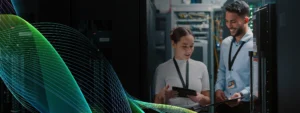The first thing you should know is that no dogs were injured in the writing of this post – though a small Wi-Fi extender pod did go through a bit of a rough patch. You see, having added said extender to improve reception in my modified work-from-home space during the pandemic, I inadvertently left it within snacking reach of my dog, Summit, one afternoon. Summit, in true Marley & Me fashion, decided to eat first and ask questions later, becoming a mobile hotspot for the duration of the extender’s presence in his G.I. tract. While everything worked out fine in the end (as they say), the whole incident has raised for me, yet again, the importance of keeping eyes on technology because the unexpected is always waiting to happen right around the corner – perhaps with big brown eyes and a wagging tail.
You see, in a way, that extender was my own kind of edge computing device – or at least an enabler of other edge computing devices, like my laptop. And I was paying it all the attention a facility manager might give to a repurposed supply closet that now houses onsite servers. But if I’d had a camera monitoring the extender – and maybe a temperature sensor to alert me to an approaching snuffling snout – I could have moved it out of harm’s way before any harm was done.
So, this is kind of a funny story (especially since Summit is totally fine, now), but the risks that can arise for unmonitored edge computing environments can be concerning. Consider the following possibilities in three growing applications for distributed IT installations that highlight the importance of remote monitoring.

Healthcare
Edge computing is booming in hospitals and other healthcare settings. In October, Computerworld Magazine reported that the research group IDC expects these organizations to spend $10.3 billion on edge computing hardware, software, and services by 2025, a 17% compound annual growth rate over five years. Just think about all the monitors and sensors that now surround a modern hospital bed or the tablet your doctor might have used for entering data during your last annual physical. The data those devices collect might well be stored on servers housed in a space never designed for its current purpose.
Now consider how those servers could be impacted by something as simple as mop water leaking under a door or a server-room air conditioning unit going down, leading to overheating. Suddenly, the very foundation of modern healthcare – access to data – could be completely compromised – all for the simple lack of localized moisture and temperature monitoring devices.
Financial services
The growth in edge computing is even more dramatic for banks, brokerages, and other financial services providers, with MarketsandMarkets anticipating 2021’s $36.5 billion sales to grow to $87.3 billion by 2026. These companies are turning to edge technologies to digitize tellerless services, reduce latency for data processing at bank branches and implement real-time fraud detection for individual transactions.
In these settings, data integrity and access are mission-critical, but they could be threatened by a simple custodian accident or a more malevolent effort to steal or damage equipment. Cameras and intrusion detection sensors installed with servers can prevent such occurrences and help troubleshoot if problems recur.
Retail
Supermarkets and other retail operators have long used edge devices to monitor refrigeration temperatures and operate point-of-sale devices. But more advanced operations are now bringing the data from these devices together into supervisory dashboards that allow staff to keep an eye on operations from a single screen. This approach is part of a larger trend to bring Internet of Things capabilities to individual stores – according to a survey by market research firm IDC, 88% of retailers have either deployed workloads to an edge location or plan to do so in the next year.
Fitting edge computing into retail settings can be tricky, though, as floor space taken up by IT equipment is floor space that isn’t generating revenue. This means servers might end up installed in a location that’s hard to reach and easy to forget. Remote monitoring can be a critical element in protecting a store’s cash flow in this situation, because if point of sale operations go down, revenues could take an instant hit.
Remote monitoring to the rescue
To better prevent and more quickly react to these types of events within your organization, consider the use of sensors, cameras, and controls that offer an easy way to monitor just about any edge computing application. Sensors on the market now offer the ability to:
- Monitor temperature, humidity, and fluids, with alert functionality when targeted parameters are exceeded.
- Provide visual security for remote equipment, enabling tracking of enters and leaves of your facility.
- Offer remote operating capabilities for facility entries – and even turn specific outlets on and off.
- Work with a software monitoring and management platform so edge computing sites can be remotely monitored with a single pane of glass type visibility.
As edge computing installations grow, bolstering visibility at these sites is becoming more important to prevent unplanned downtime. Learn more about security and environmental monitoring to better manage “the dog ate my Wi-Fi extender” moments at your edge computing sites.



